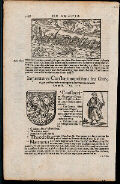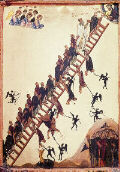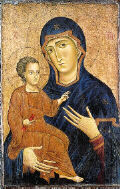
A Journal of Foreign Policy Issues

The Glory of Byzantium
incorporates masterpieces from major museums
in the United States, Greece, the Russian Federation, the Vatican,
France, Germany, Turkey, Great Britain, Hungary, Italy, Denmark,
Austria, Poland, the Netherlands, Switzerland, Israel, Belgium,
and Spain, along with works drawn from the Metropolitan MuseumÕs
own collection. Works from Turkey represent both the historic
role of Constantinople as the capital of Byzantium and the interaction
of Byzantine art with Islamic culture.
 In addition, the participation
of Ukraine, Bulgaria, Georgia, Cyprus, and Syria in the exhibition
marks the beginning of an historic new collaboration between these
countries and the Museum. Works from Orthodox monasteries such
as Iveron on Mt. Athos, St. John the Theologian on Patmos, Greece,
and St. Catherine's at Mount Sinai, Egypt, which in their
long history have never before lent abroad, add special significance
to the exhibition's exploration of the Byzantine church.
In addition, the participation
of Ukraine, Bulgaria, Georgia, Cyprus, and Syria in the exhibition
marks the beginning of an historic new collaboration between these
countries and the Museum. Works from Orthodox monasteries such
as Iveron on Mt. Athos, St. John the Theologian on Patmos, Greece,
and St. Catherine's at Mount Sinai, Egypt, which in their
long history have never before lent abroad, add special significance
to the exhibition's exploration of the Byzantine church.
The exhibition features more than 350 works of art, including mosaics, frescoes, ivories, enamels, silks, stone carvings, gems, ceramics, gold and silver secular and liturgical objects, and icons. Broadly structured in four parts, The Glory of Byzantium first demonstrates the richness of Middle Byzantine culture through many of the finest examples of its artistic heritage, a synthesis of the religious, aesthetic, and cultural influences that flowed into and out of the empire and its capital at Constantinople. The exhibition then explores the significant relationship of Byzantium to the art and culture of such neighboring peoples as the Russians and Bulgarians to the north, Armenians and Georgians to the east, and Syrian and Egyptian Christians to the far south. Finally, the exhibition documents the diffusion of Byzantine cultural influence far beyond its borders, including its emulation by, and interaction with, Islamic states in the Near East and Christian kingdoms in the Latin West.
The Religious and Secular Culture of the Second Golden Age of
Byzantium
The first section of the exhibition is devoted to the dual roles of the empire as a great political state, with its capital city of Constantinople, and as the center of Christian orthodoxy in the East. Through the presentation of both religious and secular art, including the schematic recreation of a church interior, the exhibition identifies the characteristic modes of artistic expression that resulted in a rich visual language throughout the breadth of the Byzantine Empire.
Among the objects in the exhibition that exemplify the religious
art of the period are the inlaid marble icon of St. Eudokia from
 the Archaeological Museum in Istanbul, Turkey, a double processional
icon with Virgin Hodegetria on front and Man of Sorrows on back,
from the Metropolis Church in Kastoria, Greece, and the richly
decorated frontispiece of The Liturgical homilies of Saint Gregory
of Nazianzos from the Monastery of Saint Catherine, in Sinai,
Egypt. Examples of secular art include one of a pair of gold and
cloisonnŽ enameled bracelets from the Museum of Byzantine
Culture in Thessaloniki, Greece, and the Veroli casket, an ivory
box covered with scenes from classical mythology now in the Victoria
and Albert Museum, London.
the Archaeological Museum in Istanbul, Turkey, a double processional
icon with Virgin Hodegetria on front and Man of Sorrows on back,
from the Metropolis Church in Kastoria, Greece, and the richly
decorated frontispiece of The Liturgical homilies of Saint Gregory
of Nazianzos from the Monastery of Saint Catherine, in Sinai,
Egypt. Examples of secular art include one of a pair of gold and
cloisonnŽ enameled bracelets from the Museum of Byzantine
Culture in Thessaloniki, Greece, and the Veroli casket, an ivory
box covered with scenes from classical mythology now in the Victoria
and Albert Museum, London.
Byzantium's Impact on Neighboring States
The second section of the exhibition addresses the multi-cultural
composition of the Middle Byzantine Empire exploring the interaction
of the empire's culture with that of its immediate Christian
neighbors and rivals including the conversion of the Slavic people
to Eastern Orthodoxy, an event of lasting historical significance.
 Ukraine, the Russian Federation, and Bulgaria are lending works
of exceptional importance to demonstrate Byzantium's interaction
with the Slavs, including the monumental mosaic of Saint Stephen
from Kiev, Ukraine, the Staraia Riazan' necklace from the
Kremlin, Moscow, and the great necklace from the Preslav Treasure,
now in the National History Museum, Sofia, Bulgaria. Byzantium's
interaction with its east Christian neighbors is represented by
elaborately decorated manuscripts from the Armenian Mechitaristi
Monastery at San Lazzaro, Venice. Byzantium's continuing
relationship to the Christians now in Islamic lands can be seen
through fresco fragments from The National Museum, Damascus, Syria
and the Studium Biblicum Franciscanum Museum in Jerusalem, Israel,
as well as such icons as The Heavenly Ladder of John Klimax from
the Monastery of Saint Catherine in Sinai, Egypt.
Ukraine, the Russian Federation, and Bulgaria are lending works
of exceptional importance to demonstrate Byzantium's interaction
with the Slavs, including the monumental mosaic of Saint Stephen
from Kiev, Ukraine, the Staraia Riazan' necklace from the
Kremlin, Moscow, and the great necklace from the Preslav Treasure,
now in the National History Museum, Sofia, Bulgaria. Byzantium's
interaction with its east Christian neighbors is represented by
elaborately decorated manuscripts from the Armenian Mechitaristi
Monastery at San Lazzaro, Venice. Byzantium's continuing
relationship to the Christians now in Islamic lands can be seen
through fresco fragments from The National Museum, Damascus, Syria
and the Studium Biblicum Franciscanum Museum in Jerusalem, Israel,
as well as such icons as The Heavenly Ladder of John Klimax from
the Monastery of Saint Catherine in Sinai, Egypt.
Byzantium's Interaction with the Islamic East
This section of the exhibition illuminates the reciprocal nature
of Byzantine and Islamic influences. Two exceptional manuscripts
from the library of the Topkapi Saray Museum, Istanbul, represent
 Islamic translations of Byzantine texts. Silk textiles from the
church treasuries of Auxerre and Sens in France, and such institutions
as The Cleveland Museum of Art, and The Cooper-Hewitt Museum in
New York, demonstrate the interaction of Islamic and Byzantine
motifs in these centuries. The unique copper gilt and cloisonnŽ
bowl with Islamic inscriptions and the Ascension of Alexander,
from the Tiroler Landesmuseum Ferdinandeum in Innsbruck, Austria
is the centerpiece of this gallery.
Islamic translations of Byzantine texts. Silk textiles from the
church treasuries of Auxerre and Sens in France, and such institutions
as The Cleveland Museum of Art, and The Cooper-Hewitt Museum in
New York, demonstrate the interaction of Islamic and Byzantine
motifs in these centuries. The unique copper gilt and cloisonnŽ
bowl with Islamic inscriptions and the Ascension of Alexander,
from the Tiroler Landesmuseum Ferdinandeum in Innsbruck, Austria
is the centerpiece of this gallery.
Byzanium's Interaction with the Latin West
The final galleries examine the interaction of Middle Byzantine art with that of western Europe from Italy through Scandinavia and Germany to France, England and Spain. The variety of ways in which Byzantine art reached the West are explored, including the Byzantine territorial possessions in South Italy, trade and diplomatic exchanges, marital connections to Germany, and Crusader spolia.
The Reliquary of Saint Anastasios the Persian in the shape of
a cupola church, from Aachen, Germany is among the Byzantine works
included that are known to have been brought to the Latin West
during the Middle Byzantine centuries. The Madonna and Child by
the Italian artist Berlinghiero (died by 1236) from the collection
of The Metropolitan Museum of Art is one of the outstanding examples
of western art influenced by Byzantium.